Antarctica << ant AHRK tih kuh or ant AHR tih kuh >> is the coldest, highest, brightest, driest, and windiest continent on Earth. Temperatures there almost never rise above 32 °F (0 °C). Antarctica is colder than the icy region of the Arctic Ocean centered on the North Pole. Bright ice and snow cover nearly the entire continent. Antarctica has the highest average elevation of the continents, at about 7,500 feet (2,300 meters). The South Pole, Earth’s southernmost point, lies near the center of Antarctica on a high, windy plateau.
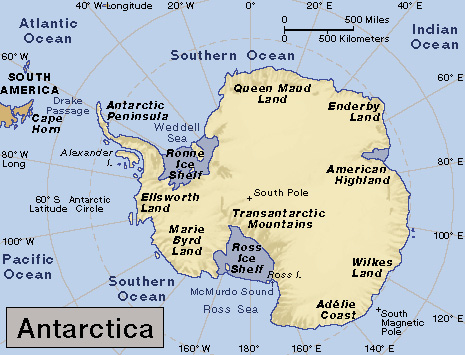
Antarctica covers about 5,400,000 square miles (14,000,000 square kilometers). It is larger in area than either Europe or Australia. Surrounding Antarctica is the Southern Ocean, which connects the Pacific, Atlantic, and Indian oceans.
Only a few small plants and insects can survive in Antarctica’s interior. But many animals thrive in and near the surrounding waters, including fish, tiny shellfish called krill, seals, whales, penguins, and other sea birds.
Long before Antarctica was discovered, ancient Greek philosophers believed that a continent covered the southern end of Earth. Antarctica was first sighted in 1820. During the mid-1800’s, explorers sailed along its coast and learned that it was large enough to be considered a continent. Inland exploration began in the early 1900’s. The Norwegian explorer Roald Amundsen reached the South Pole in 1911. In what turned out to be a dramatic race, he arrived there five weeks ahead of a British expedition led by Captain Robert F. Scott.

During the mid-1900’s, United States Navy officer Richard Byrd led air expeditions that increased scientific interest in Antarctica. In 1959, officials of 12 countries signed an international agreement called the Antarctic Treaty. This treaty provides that the continent be used mainly for research and other peaceful purposes.
Today, scientists maintain year-round research stations in Antarctica. Activities on the continent encourage international cooperation and the sharing of scientific knowledge. Several countries have claimed parts of the continent. But the Antarctic Treaty places a freeze on existing claims and prohibits new ones.
Geography
Ice and snow cover 98 percent of Antarctica. High mountain peaks and a few other bare rocky areas make up the only visible land. Underneath the ice lie features similar to those on other continents, including mountains, lowlands, valleys, and even lakes and rivers.
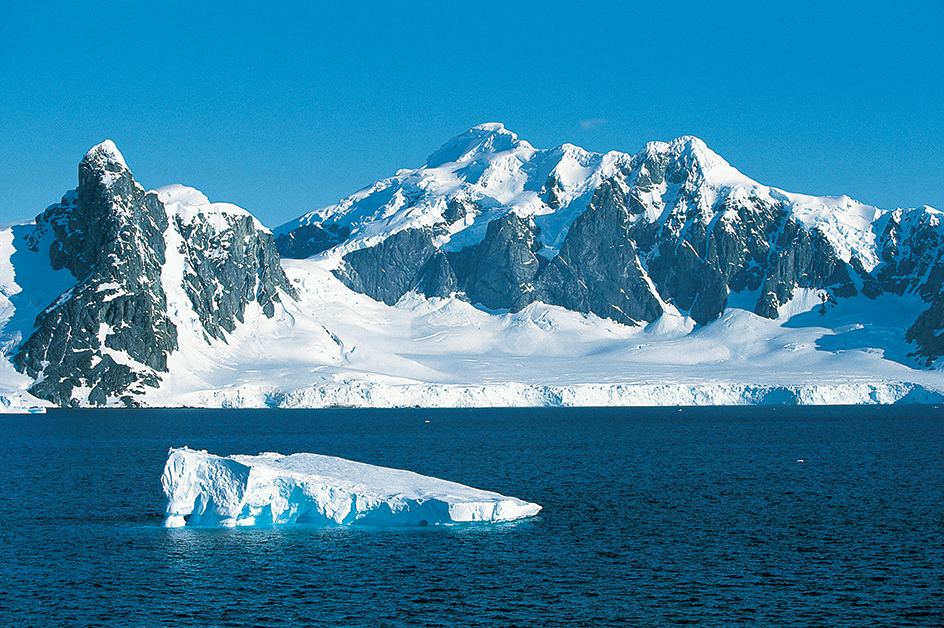
Land.
If all Antarctica’s ice were removed, the continent would be only about half its size. Much of the continent’s mass lies below sea level.
Volcanoes are common in Antarctica. Some are active, and others are hidden beneath the ice. Mount Erebus, Antarctica’s most active volcano, lies on Ross Island and rises 12,448 feet (3,794 meters) above sea level.
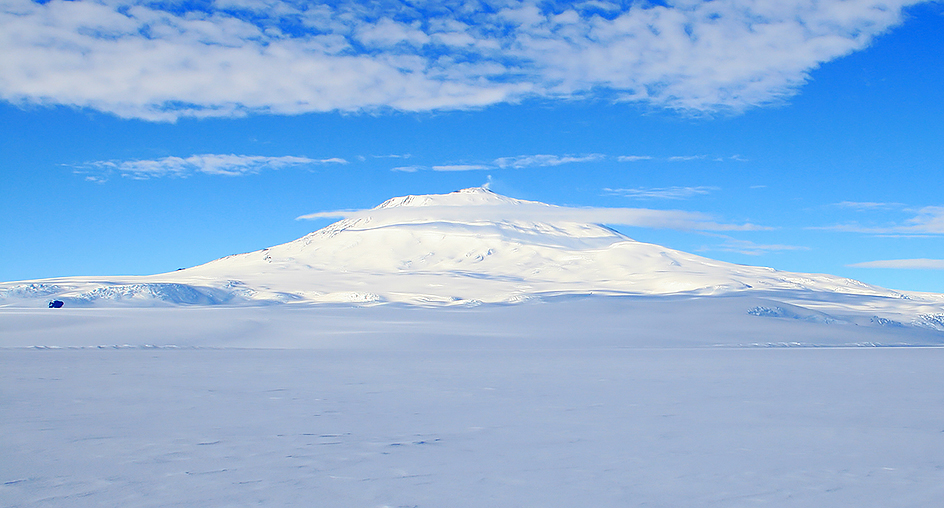
One prominent feature of the continent is the Antarctic Peninsula. The peninsula is an S-shaped mountain chain that stretches northward toward South America. It forms a continuation of South America’s Andes Mountains. Several islands lie near the peninsula. The South Shetland Islands to the west include Deception Island, an active volcano with a well-protected harbor. The harbor is the result of a violent eruption 10,000 years ago that blew out the summit crater.
A mountain chain called the Transantarctic Mountains crosses the entire continent. These mountains contain the oldest Antarctic rocks, some over 570 million years old. Several ranges make up the Transantarctic chain.
Vinson Massif, the highest point in Antarctica at 16,067 feet (4,897 meters), stands in the Ellsworth Mountains near the Antarctic Peninsula. The Transantarctic chain has the largest of the rocky, ice-free areas known as dry valleys. The valleys were carved by glaciers that once occupied them. Snow that falls in dry valleys is swept away by winds. Some of the valleys have lakes. Most of the lakes remain frozen the year around.
Loading the player...Glacier
Ice.
Antarctica has about 90 percent of the world’s ice. This ice, with a volume of 7.25 million cubic miles (30 million cubic kilometers), represents about 70 percent of the world’s fresh water. If the ice melted, Earth’s oceans would rise nearly 230 feet (70 meters), flooding coastal cities around the world. The weight of the ice causes it to spread outward and flow toward the coasts. The average thickness of the ice is over 7,100 feet (2,200 meters). The thickest ice measures 15,700 feet (4,790 meters) thick. The Transantarctic Mountains separate Antarctica’s ice into two giant ice sheets.
The East Antarctic ice sheet lies mainly in the Eastern Hemisphere. It is the larger, thicker, slower flowing, and colder of the two ice sheets. It covers 90 percent of the continent, including the South Pole. The East Antarctic ice sheet is a high-elevation polar desert about 10,000 feet (3,000 meters) above sea level. Less than 1 inch (2.5 centimeters) of snow falls there each year.
The West Antarctic ice sheet lies primarily in the Western Hemisphere. It contains Antarctica’s fastest flowing ice. The ice’s speed results from its warmer temperatures and underlying terrain that is an average of 3,300 feet (1,000 meters) below sea level. If the ice sheet melted, all that would remain of West Antarctica would be a group of islands.
Loading the player...Operation IceBridge in Antarctica
Ice near the center of the Antarctic ice sheets moves only a few feet or meters per year. But ice speeds up to many hundreds of feet or meters per year as it nears the coast. In many places, ice from the interior flows into faster-moving glaciers. Large outlet glaciers can be 250 miles (400 kilometers) long and more than 30 miles (50 kilometers) wide. They can move more than 2.5 miles (4 kilometers) per year. Fast-moving ice often breaks, forming deep crevasses (cracks). When the ice reaches the coast, it breaks off to form icebergs that are then carried out to sea. This process is called calving.
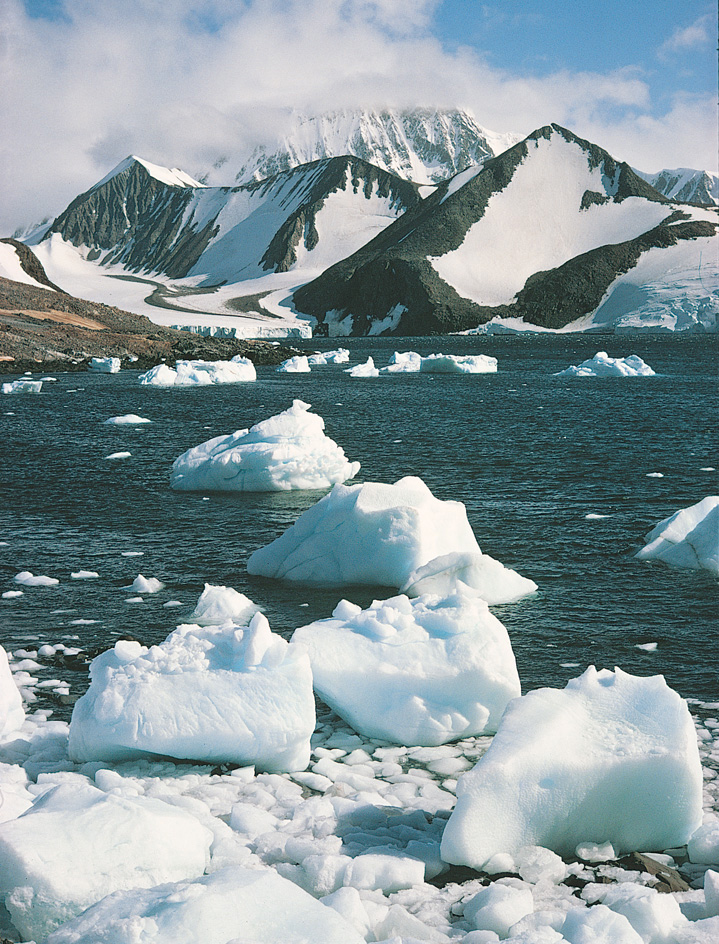
Ocean
The Southern Ocean surrounds Antarctica. The northern boundary of the ocean is 60° south latitude. Farther north, at about 55° south latitude, lies the center of an irregular band of water about 25 miles (40 kilometers) wide called the Antarctic Convergence. Within the band, cold southern waters meet warmer, saltier northern waters. At about 50° south latitude is the massive Antarctic Circumpolar Current. This current flows from east to west, circling Antarctica.

Two large gulfs cut into Antarctica at opposite ends of the Transantarctic Mountains—the Ross Sea and the Weddell Sea. Channels separate offshore islands from the mainland. For example, the Bransfield Strait separates the South Shetland Islands from the mainland.
Broad, flat, floating parts of ice sheets called ice shelves fill several of Antarctica’s bays and channels. The Ross Ice Shelf, the largest mass of floating ice in the world, spreads out over 190,000 square miles (490,000 square kilometers). It is about 2,300 feet (700 meters) thick at the inner edge and about 660 feet (200 meters) thick at the seaward edge.
Occasionally, the outer edges of the ice shelves break away and form immense tabular icebergs. Antarctic icebergs are the largest in the world. The largest iceberg ever recorded was about 4,200 square miles (11,000 square kilometers). It calved from the Ross Ice Shelf in March 2000. Icebergs eventually melt and break up in the open ocean.
Each winter, the surface of the Southern Ocean freezes into a sheet of salty ice called sea ice. In summer, this ice breaks into pieces called ice floes. Wind and waves push the floes against one another, forming thick masses known as pack ice. Some pack ice piles up in ridges against the shore. In winter, pack ice extends as far as 1,000 miles (1,600 kilometers) from the coast.
Climate
The Antarctic climate varies from extremely cold, dry conditions on the inland plateau to milder, slightly moister conditions along the coasts. Average snowfalls in East Antarctica range from 1 inch (2.5 centimeters) in the interior to 24 inches (61 centimeters) at the coast. In West Antarctica, annual snowfalls are three times this large. Along the Antarctic Peninsula, strong winds, mild temperatures, and nearby water combine to produce snowfall rates of many feet per year.
The Antarctic winter lasts from May through September. For several months, most of the continent is in continual darkness. Summer lasts from November through February. July temperatures inland range from a low of –94 °F (–70 °C) to a high of –40 °F (–40 °C). July temperatures range from –22 °F (–30 °C) to –5 °F (–21 °C) on the peninsula’s coast. January temperatures range from –31 °F (–35 °C) to 5 °F (–15 °C) inland. They reach 32 °F (0 °C) on the coast. Northern islands may have summer temperatures of up to 50 °F (10 °C). Scientists recorded the world’s lowest temperature, –128.6 °F (–89.2 °C), at Antarctica’s Vostok Station, on July 21, 1983.
Strong, bitter winds make the Antarctic air feel even colder than it is. Winds that sweep downward from the plateau can average 44 miles (70 kilometers) per hour. Gusts often reach the coast at 120 miles (190 kilometers) per hour. On the plateau, winds blow the snow into ridgelike snow dunes called sastrugi. The sastrugi measure up to 6 feet (1.8 meters) tall.
Antarctica’s climate has not always been so cold. Geologists think Antarctica was once part of a giant supercontinent called Gondwanaland. This huge landmass also included what are now Africa, Australia, India, and South America. By about 140 million years ago, Gondwanaland had begun to break apart. The parts slowly drifted to their present locations.
Many millions of years ago, Antarctica was free of ice. Scientists have found fossils of trees, dinosaurs, and small mammals that once lived there. Glaciers began to form in East Antarctica around the South Pole about 38 million years ago. They started in a rugged area called the Gamburtsev Mountains, now buried beneath the East Antarctic ice sheet. These glaciers grew rapidly around 13 million years ago. The East Antarctic ice sheet has remained roughly the same size since then. The West Antarctic ice sheet, on the other hand, has advanced and retreated many times as Earth’s climate has repeatedly warmed and cooled.
Ice sheets preserve a long and detailed record of past climate. As fresh snow is buried and compressed into ice, samples of the atmosphere are trapped in tiny air bubbles. Scientists can drill into the ice and remove a long, vertical sample called an ice core. Such a sample provides a record of the atmosphere at various times. Deeper parts of the core represent the more distant past. Slight differences in the chemical composition of the ice provide additional information on atmospheric temperature and ancient weather patterns. Antarctic ice cores provide an important way of learning about changes in Earth’s climate over the past million years.
Living things
Only a few small plants and insects can survive in Antarctica’s dry interior. But various living things thrive in and near the surrounding waters.
Few plants grow in Antarctica because of the ice-covered land and the harsh climate. Mosses are the most common Antarctic plants. They cling to rocky areas, mostly on the coasts. Only two flowering plants grow in Antarctica. Both live on the northern part of the Antarctic Peninsula. One of them is a grass that forms dense mats on sunny slopes. The other, an herb, grows in short, cushionlike bunches.
Simpler organisms known as algae grow on snow, in lakes, and on ice surrounding the continent. Some algae give snow a pink or green tinge. Other organisms called lichens cling to rocks as mosses do. Some lichens survive by bunching together to conserve water. Scientists have discovered rows of black, white, and green lichens growing in tiny cracks in dry valleys. Small plants and algae also drift on the surface of the Southern Ocean.
Only a few insects and other tiny animals spend their entire lives on the Antarctic mainland. The continent’s largest land animal is a wingless midge, a type of fly no more than 1/2 inch (12 millimeters) long. Most land animals live at the edges of the continent. To avoid freezing to death, some lice, mites, and ticks cling to mosses, the fur of seals, or the feathers of birds.
Unlike the continent, the Southern Ocean has abundant wildlife. The most common ocean animal is krill, a small, shrimplike creature that feeds on tiny floating organisms. Many Antarctic animals depend on krill for food. Several countries also catch krill as a protein-rich food for people. Many Antarctic animals also eat squid. In addition, about 100 kinds of fish live in the ocean, including Antarctic cod, icefish, and plunderfish.
Several kinds of whales migrate to Antarctica for the summer. Blue whales, fin whales, humpback whales, minke whales, right whales, and sei whales feed on krill. The blue whale is the largest animal ever. This rare giant grows up to 100 feet (30 meters) long. Antarctic whales that eat fish and squid include killer whales—also called orcas—and southern bottlenose whales, southern fourtooth whales, and sperm whales. Killer whales also hunt seals, penguins, and smaller whales.
Various kinds of seals live in Antarctica. They spend most of their lives in the water. Many of them nest on the coasts. The Antarctic fur seal nests on nearby islands. The largest seal in the world, the southern elephant seal, feeds on squid and may reach a length of 16 feet (5 meters). Ross seals and Weddell seals eat fish and squid. Antarctic fur seals and crabeater seals eat krill. Leopard seals hunt other seals and penguins.
During the 1800’s and early 1900’s, hunters greatly reduced the number of whales and Antarctic fur seals. Today, international wildlife laws prohibit or restrict the killing of these animals.
Penguins are the animals most often associated with Antarctica. These birds cannot fly, and they waddle awkwardly on land. But they are skillful swimmers. Six kinds of penguins breed on the continent. Adélie penguins, the most common kind, build nests of pebbles on the coasts. The tall, quieter emperor penguin grows to about 3 feet (1 meter). After the female emperor penguin lays an egg, the male rests the egg on his feet and warms it with the lower part of his belly. Chinstrap, gentoo, king, and macaroni penguins nest on the Antarctic Peninsula and on islands. Rockhopper penguins nest only on islands north of Antarctica.
Loading the player...Penguins
More than 40 kinds of flying birds spend the summer in Antarctica. Many types nest on land but spend most of their time diving for food. These birds include albatrosses, prions, and a large group of sea birds known as petrels. Other birds, such as cormorants, gulls, skuas, and terns, return to land more frequently. Some of them steal food from the nests of other birds. Some land birds, such as sheathbills, nest on the peninsula. Others, including pintails and pipits, nest on islands.
Exploration
People wrote about a southern continent centuries before Antarctica was discovered. Ancient Greek philosophers supposed that a landmass at Earth’s southern end was needed to balance the weight of the northern lands. During the A.D. 100’s, the Greek geographer Ptolemy gave this undiscovered continent the Latin name Terra Australis Incognita, meaning unknown southern land. He believed the land was populated and fertile. The name Antarctica later came from two Greek words meaning opposite the bear. The Bear is a constellation seen in Earth’s northern sky.
People first sighted Antarctica in 1820. During the mid-1800’s, explorers sailed along its coast. They learned that it was large enough to be considered a continent. Inland exploration began in the early 1900’s. The Norwegian explorer Roald Amundsen became the first to reach the South Pole in 1911. In what turned out to be a dramatic race, he arrived there five weeks ahead of a British expedition led by Captain Robert F. Scott.
Early exploration.
In 1772, the English navigator James Cook began his search for the southern continent. In January 1773, he crossed the Antarctic Circle, an imaginary line circling Earth at 66° 33′ south latitude. A year later, Cook reached 71° 10′ south latitude. Huge icebergs and thick ice floes prevented him from going farther, however, and he never sighted land.
Nobody knows who first saw the Antarctic continent. Many historians divide the credit among three men who made separate voyages in 1820. In January of that year, Captain Fabian von Bellingshausen of the Russian Imperial Navy reported reaching a point only 20 miles (32 kilometers) from the Antarctic Peninsula. Some historians believe that he saw land but thought it was ice.
That same month, Captain Edward Bransfield of the British Navy journeyed south of the South Shetland Islands and probably saw the Antarctic Peninsula. In November, an American sealer named Nathaniel Brown Palmer reported seeing land during a sealing expedition in the same area. Some geographers later called the peninsula Graham Land in honor of James Graham, the head of the British Navy in Bransfield’s time. Others called it Palmer Land. The United States and the members of the Commonwealth of Nations finally agreed to the term Antarctic Peninsula in 1964.
Historians also are unsure of who first set foot on Antarctica. Some believe that an American sealer named John Davis went ashore at Hughes Bay on the tip of the peninsula in 1821. But Davis did not know if he had reached the continent or an island.
In 1823, a British sealer named James Weddell sailed south in search of hunting waters. He reached about 74° south latitude, farther than earlier voyagers had sailed, and found what is now called the Weddell Sea.
In 1831, the English whaler John Biscoe became the first to spot land in East Antarctica. He named it Enderby Land after the whaling company that owned his ship.
In 1837, the king of France sent Lieutenant Jules Dumont d’Urville to claim some southern lands for France. D’Urville’s first attempt led him to discover what is now called Joinville Island, off the tip of the Antarctic Peninsula. He began his next Antarctic voyage from Tasmania, an island south of the Australian mainland. In January 1840, he sighted icy cliffs rising along the East Antarctic coastline. Many small penguins dotted the pack ice that blocked his way to the land. D’Urville named both the land and the penguins after his wife, Adélie.
About the time that d’Urville sighted land, U.S. Navy Lieutenant Charles Wilkes headed an expedition to perform scientific research. Wilkes’s greatest contribution to Antarctic studies was his coastal exploration. His ship moved from the Adélie Coast toward Enderby Land, tracing over 1,500 miles (2,400 kilometers) of coastline.
From 1839 to 1843, the British explorer James Clark Ross made several discoveries. Ross was the first person to go beyond the pack ice surrounding Antarctica. He sailed into the gulf that is now called the Ross Sea. Ross also discovered an island with two volcanoes, which he named after his ships, Erebus and Terror. He found the gulf barricaded by a towering sheet of ice, now known as the Ross Ice Shelf.
In 1895, a Norwegian businessman named Henryk Johan Bull made the first known landing on the Antarctic mainland. He and his whaling crew went ashore at Cape Adare, a point on the Ross Sea facing New Zealand.
The “Heroic Era.”
The first two decades of the 1900’s are often called the “Heroic Era” of Antarctic exploration. In this period, people learned much about the geography and environment of the continent. It was also during this period that explorers first reached the South Pole.

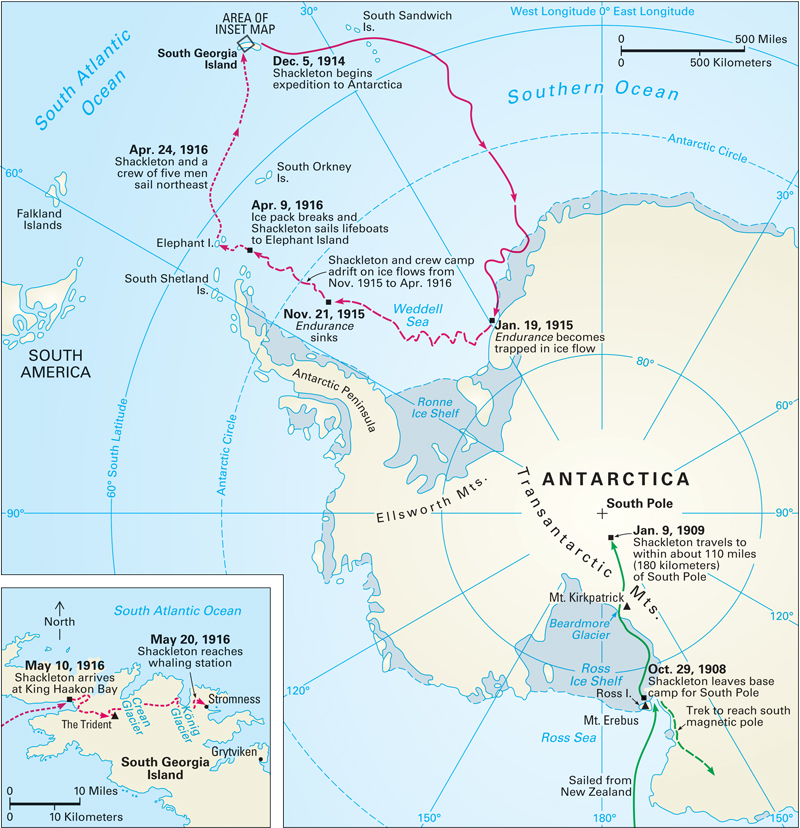
The first inland exploration of Antarctica took place from 1901 to 1904. Robert Falcon Scott of the British Navy led a team of explorers and scientists to the Ross Sea. In November 1902, Scott and two other men headed south across the Ross Ice Shelf. But illness, harsh weather, and lack of food forced them to rejoin the team earlier than planned. Another group moved up a glacier through the Transantarctic Mountains and reached the edge of the harsh inland plateau.
Ernest Shackleton, a member of Scott’s team, returned to Antarctica in 1907. Part of his expedition searched for the south magnetic pole in a remote area of East Antarctica, nearly reaching it in January 1909. At the same time, the main group headed for the south geographic pole, the meeting point of lines of longitude. Food shortages forced the men to turn back early. But they had come within about 110 miles (180 kilometers) of the pole, close enough to prove that the pole was on land rather than beneath a frozen sea.
In June 1910, Captain Scott left London, hoping to win for the United Kingdom the honor of reaching the South Pole first. In October, while Scott was in Australia, he received a telegram from the Norwegian explorer Roald Amundsen. The telegram informed Scott that Amundsen, too, was going to Antarctica. Amundsen originally had hoped to be the first to reach the North Pole. He switched his goal when he heard that the North Pole had been reached. The race to the South Pole became one of the most famous events in Antarctica’s history. 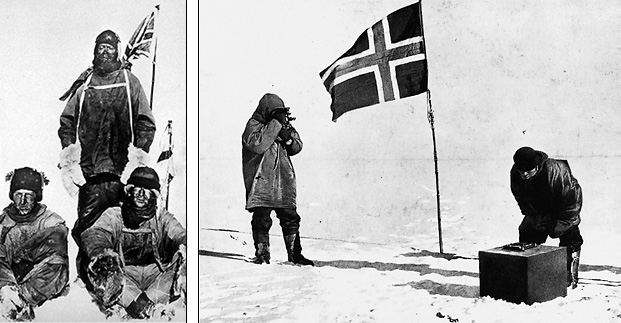
Amundsen and his four assistants began crossing the Ross Ice Shelf from its northeastern corner, at the Bay of Whales, on Oct. 19, 1911. To reach the inland plateau, they had to carve their own route along an unexplored glacier in the Queen Maud Mountains, a part of the Transantarctic Mountains at the southern edge of the ice shelf. The men journeyed on skis, while 52 dogs pulled their four sleds of supplies. Amundsen marked his route and food storage areas with mounds of snow. He shot the weakest dogs for food, when they were no longer needed to pull the sleds.
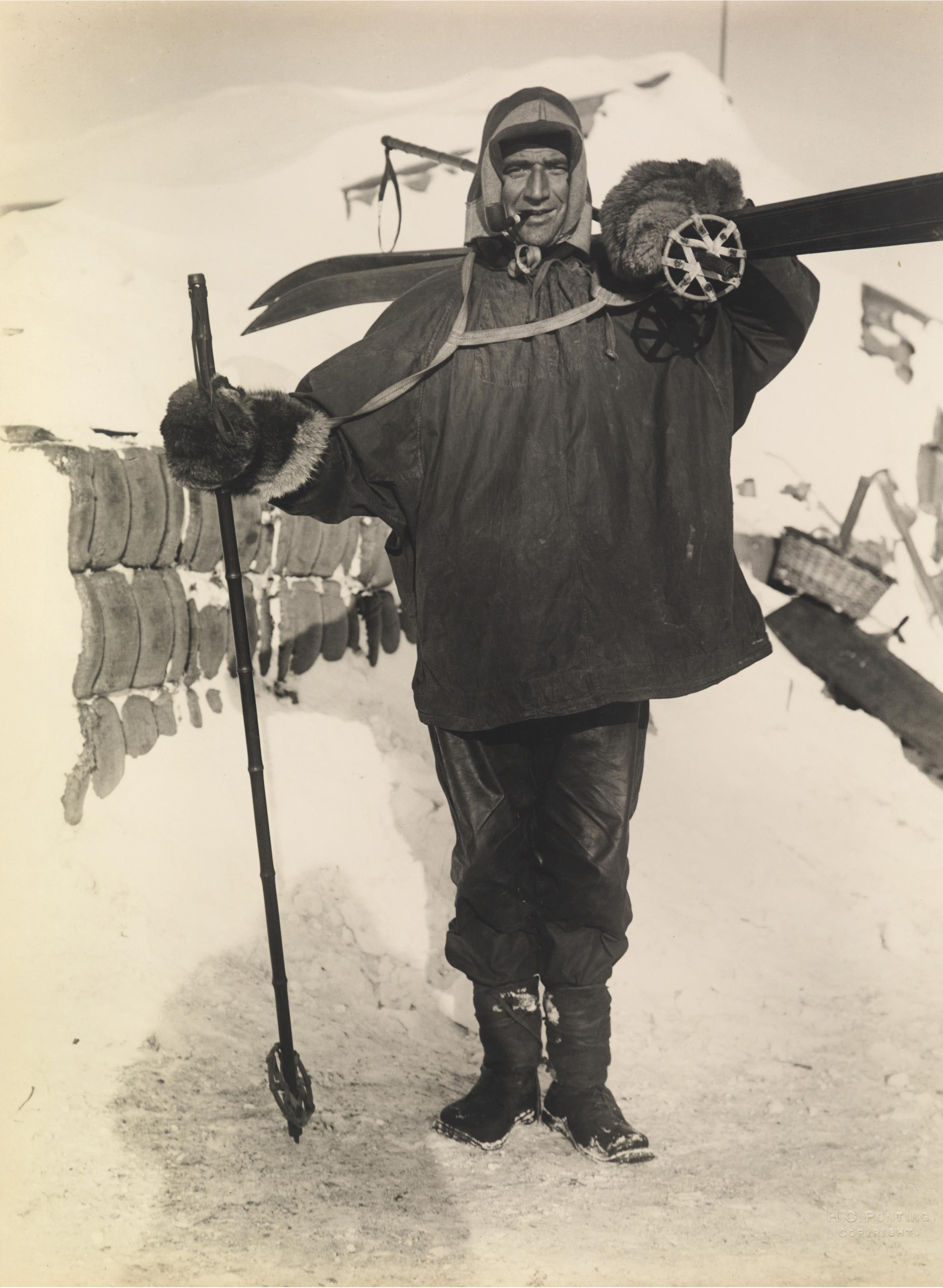
Scott set out with 15 other men on Nov. 1, 1911, from Cape Evans, Ross Island, at the northwestern corner of the Ross Ice Shelf. This location was about 800 miles (1,300 kilometers) from the pole, about 60 miles (100 kilometers) farther than Amundsen’s starting point. However, Scott’s expedition reached the plateau by way of the Beardmore Glacier, a known route. Scott tried using motorized sleds to carry some supplies and using ponies as well as dogs to pull other sleds. But the ponies and motor sleds bogged down in the soft snow. Eventually, the men had to drag the sleds, and food soon ran low. Scott crossed the plateau accompanied by four men.
Amundsen’s group arrived at the South Pole on Dec. 14, 1911. They used special navigating instruments to calculate their position. Amundsen left behind his tent, a Norwegian flag, and a message for Scott. The group then headed back to their base, which they reached on Jan. 25, 1912. By that time, only 11 dogs remained, but all five men were in good health.
Scott’s group reached the pole on Jan. 17, 1912, finding Amundsen’s flag. Cold, hunger, and exhaustion had severely weakened the explorers. They photographed themselves at the pole and began their return. All five men perished on the way. Two of them died after they were injured on the trail. Late in March, a long blizzard forced Scott and his two remaining assistants to make camp only 11 miles (18 kilometers) away from food and supplies. A search party found their frozen bodies inside the tent eight months later.
Exploration by air
provided a new way to study Antarctica. In 1928, the Australian explorer Sir Hubert Wilkins surveyed the Antarctic Peninsula and nearby islands in the first airplane voyage over the continent.

In November 1929, the U.S. Navy officer Richard E. Byrd led the first flight over the South Pole. A Norwegian-American pilot, Bernt Balchen, flew Byrd’s crew from the Bay of Whales to the pole and back. The flight lasted less than 16 hours. This journey was part of an expedition that Byrd supervised from 1928 to 1930. In a second expedition from 1933 to 1935, Byrd and his assistants traveled by plane and tractor over the Antarctic interior. They studied the ice, Earth’s magnetism, cosmic rays, weather, and geology.
In 1935, the U.S. engineer Lincoln Ellsworth and the English-born pilot Herbert Hollick-Kenyon took off from Dundee Island, north of the Antarctic Peninsula, hoping to make the first flight across the continent. Near the Weddell Sea, they discovered what are now called the Ellsworth Mountains. Their plane had to land four times because of storms and a fuel shortage. They finally completed the crossing on foot at the Bay of Whales.
In 1946 and 1947, Byrd commanded the U.S. Navy’s Operation Highjump, the largest Antarctic expedition by a single country. Operation Highjump sent 4,700 men, 13 ships, and 23 airplanes and helicopters to Antarctica. The expedition members discovered new land, including 26 islands. They photographed about 1,400 miles (2,300 kilometers) of previously unexplored coastline.
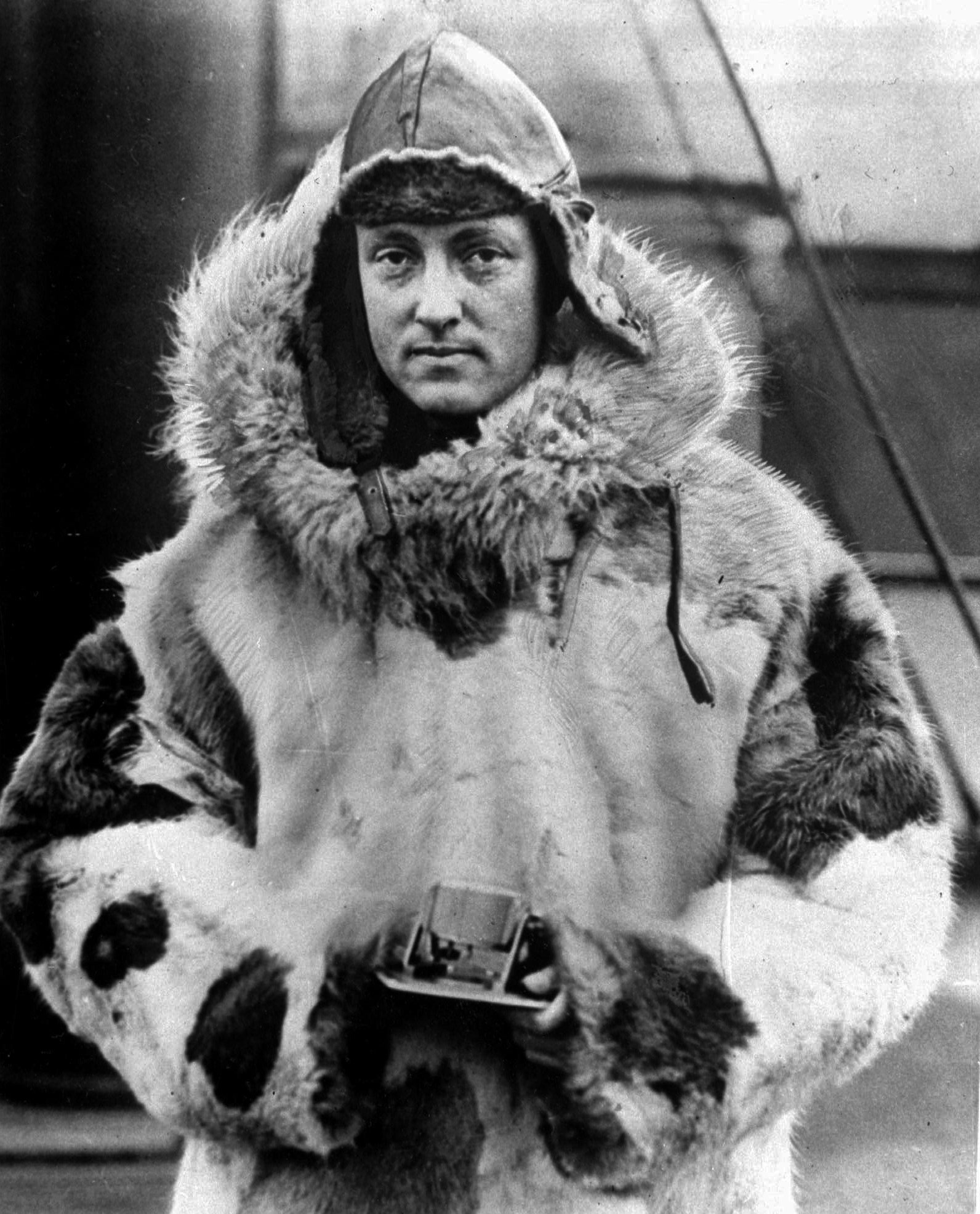
That same year, Captain Finn Ronne led a private U.S. air expedition to West Antarctica. Ronne explored areas of the Weddell Sea that had never been seen. The crew included Ronne’s wife, Edith, and Jennie Darlington, the wife of his chief pilot. They were the first women to spend a winter on the continent.
The International Geophysical Year.
Scientific knowledge of Antarctica increased rapidly during the International Geophysical Year (IGY). The IGY was a global program in which scientists coordinated observations and shared their findings. It began on July 1, 1957, and ended on Dec. 31, 1958.
As part of the IGY, 12 countries established over 50 scientific stations on Antarctica and nearby islands. These countries were Argentina, Australia, Belgium, Chile, France, Japan, New Zealand, Norway, South Africa, the Soviet Union, the United Kingdom, and the United States. The United States set up a station at the South Pole, five coastal stations, and one inland station. The Soviet Union built a station at a point it named the Pole of Inaccessibility. This station, called Vostok, lies in East Antarctica, far inland from all coasts.
IGY researchers in Antarctica studied such topics as earthquakes, gravity, magnetism, oceanography, and solar activity. Meteorologists (scientists who study weather) determined air pressure, humidity, temperature, and wind direction and prepared Antarctica’s first complete weather charts. Glaciologists (scientists who study ice) measured the thickness of the ice. Geologists studied the land formations.
During the IGY, the British geologist Vivian Fuchs headed the first land crossing of the continent. The Commonwealth of Nations organized the expedition, which covered 2,158 miles (3,473 kilometers). Fuchs left on Nov. 24, 1957, from the shore of the Weddell Sea, with dogs and snow tractors. A team led by the New Zealand explorer Sir Edmund Hillary placed food and supplies along the second part of the trail. Hillary met Fuchs at the South Pole in January 1958. Fuchs reached McMurdo Sound in the Ross Sea on March 2, 1958.
Seven of the 12 countries that built Antarctic bases for the IGY claim parts of Antarctica as their national territory. The parts are shaped like pie slices, with the South Pole at the center. Many nations, including the United States, do not recognize these claims.
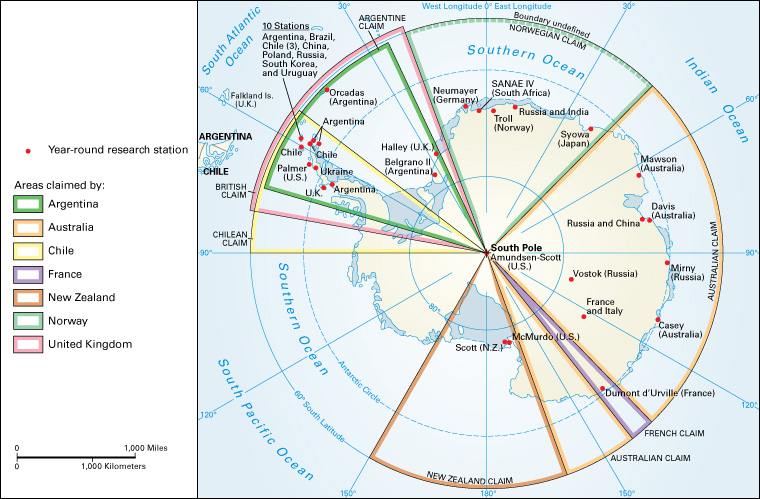
International agreements.
In 1959, at the end of the IGY, officials of the 12 countries signed the Antarctic Treaty. This agreement freezes all current territorial claims and prohibits new claims. It allows people to use Antarctica only for peaceful purposes, such as scientific research and tourism. It also requires scientists to share the results of their studies. The treaty forbids military forces in Antarctica, except those assisting scientific expeditions. It also outlaws the use of nuclear weapons and the disposal of radioactive wastes in Antarctica.
Since 1961, when the Antarctic Treaty took effect, a number of other nations have joined the treaty. Many of these nations have set up scientific programs in Antarctica. In 1991, the Antarctic Treaty nations signed the Madrid Protocol. This agreement, which went into effect in 1998, establishes Antarctica as a natural reserve devoted to peace and science. The protocol prohibits mineral exploitation in Antarctica and establishes strict rules designed to protect the Antarctic environment.
Scientific research.
Today, more than 40 year-round scientific stations operate on the continent and nearby islands. The National Science Foundation maintains three year-round U.S. stations: (1) Amundsen-Scott South Pole Station, (2) McMurdo Station on Ross Island, and (3) Palmer Station on Anvers Island near the Antarctic Peninsula. Other research stations are maintained by Argentina, Australia, Brazil, Bulgaria, Chile, China, Finland, France, Germany, India, Italy, Japan, New Zealand, Norway, Poland, Russia, South Africa, South Korea, Spain, Ukraine, the United Kingdom, and Uruguay.
McMurdo Station has Antarctica’s largest community. About 1,200 scientists, pilots, and other specialists live there each summer. About 250 people stay through the dark, frigid winter. A water plant collects and desalts seawater from McMurdo Sound. An aggressive recycling program minimizes unusable waste. Powerful ships called icebreakers plow through the ice, arrive with people and supplies, and leave with waste materials and scientific samples. The station also has runways and a helicopter pad.
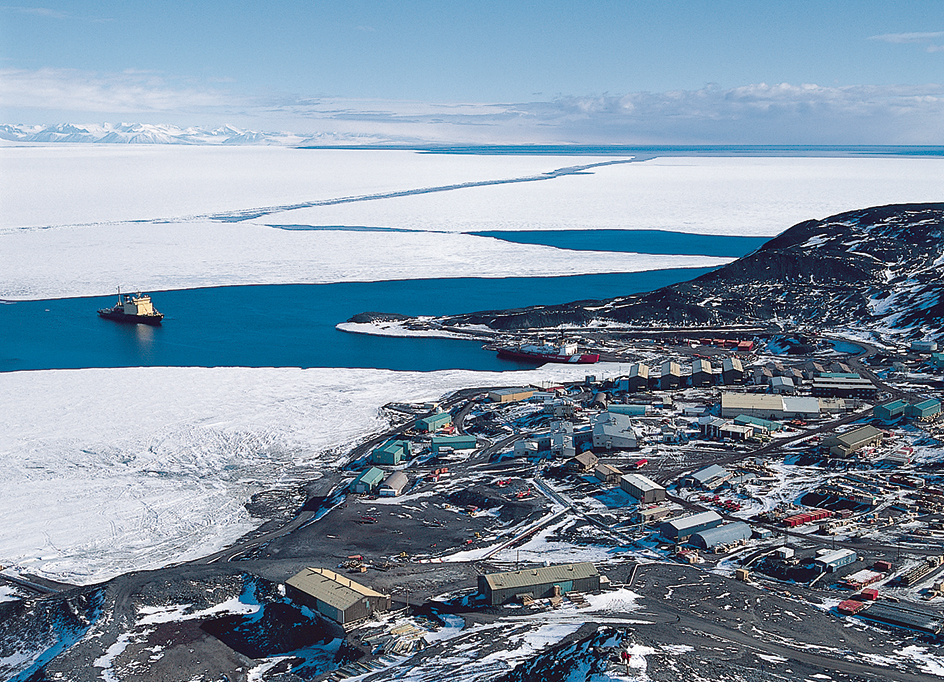
South Pole Station is smaller. It has a summer population of about 200. Its winter crew is about 12. Cargo planes with skis from McMurdo Station service it.
Loading the player...McMurdo Station
Palmer Station supports an even smaller population. Its population shrinks to just four during the winter. It is serviced by ship during the summer.
Summer activities in Antarctica vary. Geologists collect rock samples from the ice-free dry valleys of the Transantarctic Mountains. Glaciologists measure the speed of ice flow, ice thickness, and properties beneath the ice at many of the most rapidly moving and changing locations. Physicists at the South Pole have converted a cubic kilometer of the ice into a vast detector of high-energy particles. They did this by placing over 1,000 sensitive detectors within the ice. Astronomers have many specialized telescopes at the South Pole. These telescopes take advantage of the six-month-long days and nights and the thin, stable atmosphere. On the coasts and at sea, biologists observe how animals adapt to their environment. Winter restricts scientists to such activities as recording weather data and studying earthquakes and solar radiation.
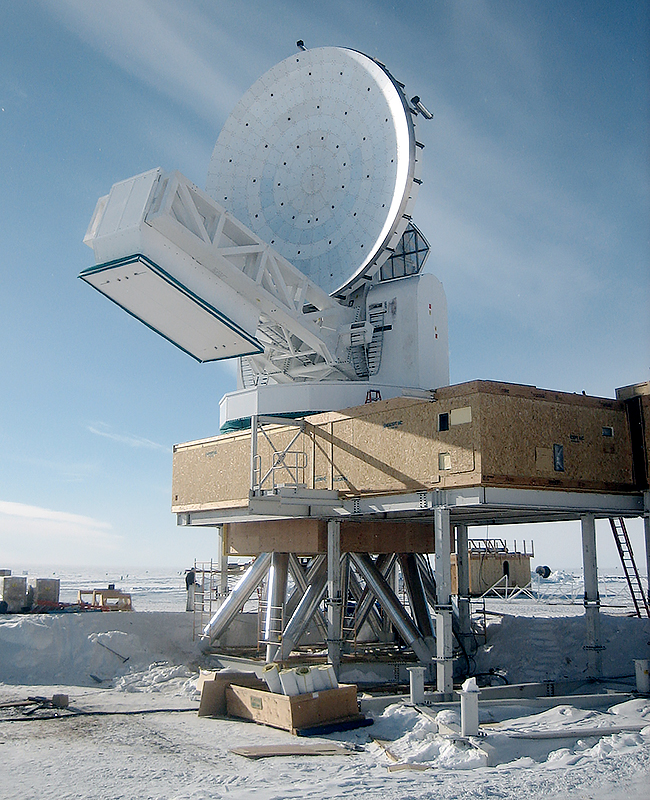
One important area of research in the Antarctic has been ozone in the atmosphere. Ozone is a form of oxygen. It is concentrated in an atmospheric layer that ranges in altitude from about 9 to 18 miles (15 to 30 kilometers). This layer protects all living things from certain harmful rays from the sun. In the mid-1980’s, scientists discovered that the ozone layer over Antarctica was thinning. Evidence pointed to manufactured compounds called fluorocarbons as a major cause of this “ozone hole.” Prompted by these findings, nations around the globe signed the Montreal Protocol in 1987, banning the use of chlorofluorocarbons, a major cause of ozone loss.
Research in Antarctica can answer important questions about the past, present, and future of Earth. Much scientific work there focuses on issues related to global climate change, in particular global warming. Global warming is an ongoing increase in average global surface temperatures.
Loading the player...Larsen Ice Shelf
Some of this research focuses on the causes and effects of ice loss in Antarctica. Rates at which ice flows into the sea are increasing in many locations, causing sea level to rise. This rise in sea level threatens coastal regions around the world. Predicting the fate of the ice sheet as temperatures continue to increase will help people anticipate and manage coastal changes around the world.
In 2007, scientists from dozens of nations launched a two-year study of the Arctic and Antarctic called the International Polar Year. The investigation involved more than 200 research projects. They focused on assessing the status of the polar regions and determining how global warming will affect the polar and global climate and the inhabitants of the polar regions.
Since the late 1900’s, it has become easier to travel to Antarctica. The number of tourists visiting the continent has increased rapidly. Researchers face challenges in managing the Antarctic environment as the continent’s human population increases.
During the early decades of the 2000’s, scientists’ concern about rising temperatures—and the resulting melting of ice in Antarctica—continued to grow. On Feb. 6, 2020, the temperature at the Esperanza Research Station, an Argentine scientific site on the Antarctic Peninsula, reached 64.9 °F (18.3 °C). It was the highest temperature ever recorded on Antarctica.
